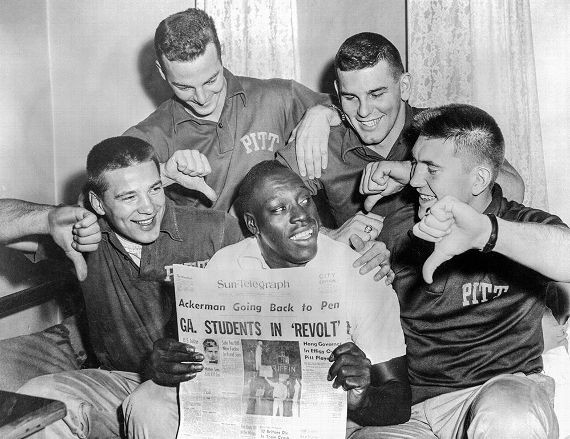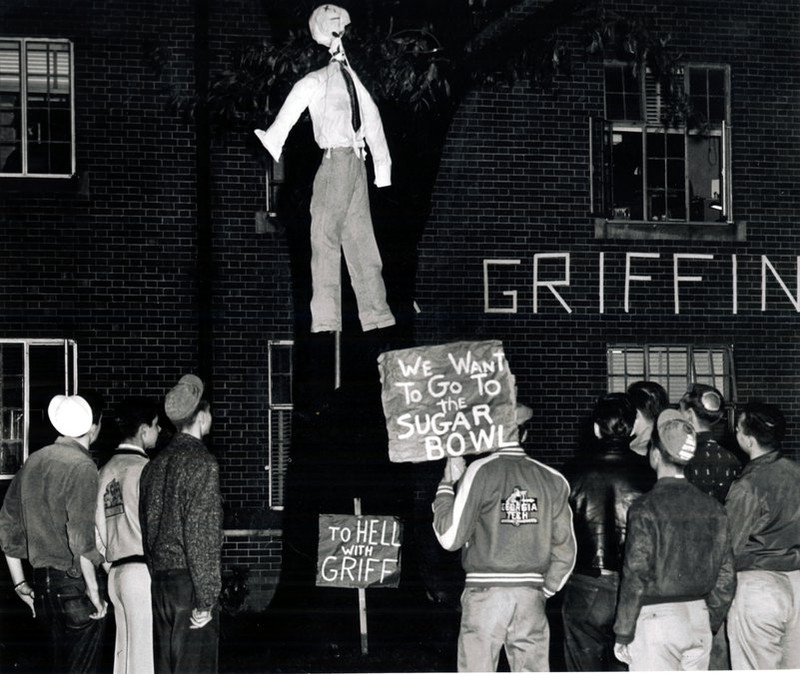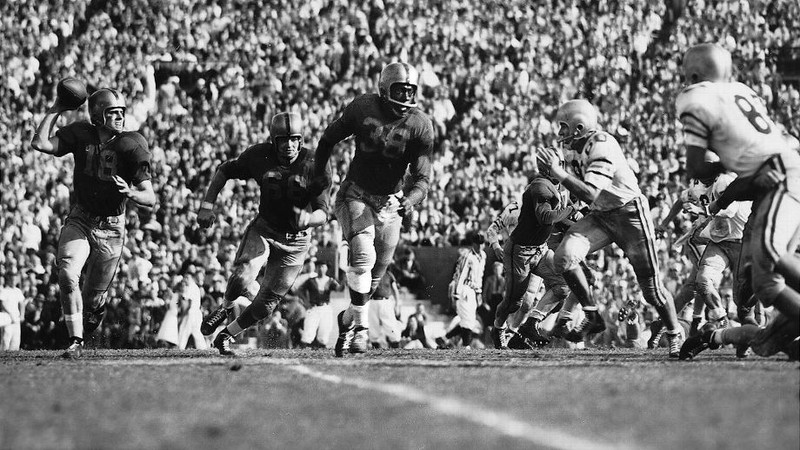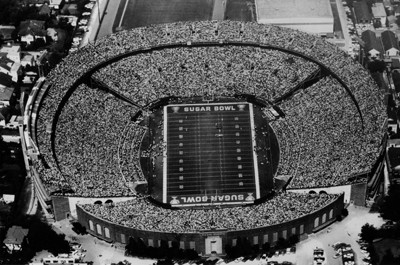Tulane Stadium
Introduction
Text-to-speech Audio
Images
Bobby Grier is surrounded by his supportive teammates. Grier's upcoming presence in the Sugar Bowl sparked protest from Georgia's Governor, Marvin Griffin, Jr. Griffin was subsequently chided in the media and by Georgia Tech students.

George Tech students protest Governor Marvin Griffin's opposition to the Sugar Bowl. Griffin was a segregationist and thought his opposition would play well with his political base. However, it mainly sparked outrage.

Bobby Grier (center) played in the 1956 Sugar Bowl as a fullback for the Pittsburgh Panthers. Though his team lost 7-0, his presence in the game signified the first time major college football in the South was integrated.

Bird's-Eye view of Tulane Stadium as the host of the Sugar Bowl

Backstory and Context
Text-to-speech Audio
Tulane Stadium in New Orleans, Louisiana was an 80,000 football facility located on the campus of Tulane University. A notable venue in the history of college athletics, Tulane Stadium served as the host of one of college football’s top-tier bowl games: the Sugar Bowl. Held every January from 1935 to 1974, the Sugar Bowl at Tulane Stadium featured two of the most prominent teams in college football, usually with at-least one team from the South. Its 1956 matchup featured the Georgia Tech Yellow Jackets of the Southeastern Conference against the University of Pittsburgh Panthers, a college football independent. Though not an unusual matchup on paper, the buildup to this game was filled with controversy. Defined by the segregationist tendencies of Southern politicians and set against the backdrop of the emerging Civil Rights Movement, many who attended Tulane Stadium to watch the 1956 Sugar Bowl saw something they never had before: a Black football player. It was at Tulane Stadium that major college football in the deep South was integrated for the first time.
Bobby Grier was a student at the University of Pittsburgh, playing fullback and linebacker for its football team. Grier and the Panthers fought their way through the 1955 schedule to a 7-3 regular season record that included wins over fifth-ranked Duke, sixth-ranked West Virginia, and rival Penn State. Ranked eleventh in the country, the Pittsburgh Panthers were invited to the Sugar Bowl to face the Georgia Tech Yellow Jackets in New Orleans. The Yellow Jackets, who were having a good season of their own, were a Sugar Bowl staple, having been invited to the game two of the previous three years. Their game in 1956 was different, however because Grier, who was Black, was an important fixture of Pittsburgh’s team. Pittsburgh wasn’t the first northern team with Black players to be invited to the Sugar Bowl. They were, however, the first to insist on using them during the game. For Pittsburgh, their motto was simple: "No Grier, No Game."4
Integration was a dirty word in the South during the 1950s, and for Georgia Governor Marvin Griffin, the news that Bobby Grier was going to play in the Sugar Bowl against Georgia Tech stung as if it came from Satan himself. Griffin was a staunch segregationist, standing in solidarity with the likes of George Wallace and Bull Connor. To have a team from his state playing an integrated football team in the South wouldn’t be good for his base of support. For political reasons, it could not happen. Griffin publicly came out against Georgia Tech playing Pittsburgh in the Sugar Bowl, exclaiming, “the South stands at Armageddon.”4 Griffin even asked Georgia’s Board of Regents to intervene, but they refused to fold to his demands. Marvin Griffin thought his opposal of Bobby Grier and the Pittsburgh Panthers would be popular among his constituents; in fact it was quite the opposite.
Upon hearing of the Governor’s opposition, the Georgia Tech student body retaliated. The students wanted to see their football team play in the postseason, regardless of what it meant for segregation. Waves of Georgia Tech students flooded the lawn and the areas surrounding the Governor’s mansion in Atlanta, burning Marvin Griffin in effigy. They held up signs saying “We want to go to the Sugar Bowl” and “To Hell with Griff.”4 Marvin Griffin could not stop this game from being played.
Though the game was going to be played, the obstacles that Grier and his team faced didn’t end. As a treat for a good season, teams on bowl trips are generally invited to stay in nice hotels and attend fancy dinners. The Georgia Tech football team was invited to stay at the Roosevelt Hotel in downtown New Orleans, one of the city’s finest. Pittsburgh’s team, however, did not experience the same luxury. Because Louisiana law forbade white and Black people from lodging in the same building, Grier and his teammates had to stay in the dorms at Tulane University. Even though his team couldn’t enjoy the same luxuries as others, Bobby Grier’s mere presence in New Orleans for the Sugar Bowl signaled a changing of the times.
The 1956 Sugar Bowl game itself isn’t particularly noteworthy. A defensive battle, Georgia Tech scored the game’s only touchdown after a controversial pass interference penalty called on Grier. It’s alleged that Grier ran into one of Georgia Tech’s receivers, interfering with the pass attempt. However, witnesses claimed that it was Grier who ended up on the ground. There is no evidence to suggest that this call, made by a Southeastern Conference official, was racially motivated. But it was the difference in the game, as Georgia Tech won by a score of 7-0.
While Bobby Grier’s presence on the field at Tulane Stadium was important, what happened in the stands that day was equally significant. Black and white fans sitting together at any public event was illegal under Louisiana law. At sporting events, tickets were designated as either “negro” or “caucasian.” Generally, the “caucasian” seats were located in spots with good sightlines such as behind the team’s benches, whereas “negro” seating was located in the corners and behind the endzones where it was harder to view the game. But the Pittsburgh fans didn’t heed these designations. Pittsburgh’s section of fans was one of the first times fans at a Southern sporting event were integrated. The Pittsburgh Panthers came to New Orleans and broke the rules, and in doing so advanced the cause of Civil Rights in the South.
Progress is a long and winding road. To say that Bobby Grier single-handedly integrated college football with no reverberations would be a fallacy. After Grier's appearance in the Sugar Bowl, Louisiana passed the Anti-Mixing Statute of 1956, which forbade integration of events in Louisiana. Because of this statute, the Sugar Bowl did not host another integrated team from the North until 1965, when Syracuse played LSU. In fact, Southern college football did not begin to be integrated on a large scale until Bear Bryant’s Alabama Crimson Tide signed John Mitchell in 1971. Because of Bobby Grier and the Pittsburgh Panthers at Tulane Stadium, college football in the deep South came one step closer to integration and the inclusion of Black athletes. Despite the opposition of those in power, unlikely factions were able to come together and play the game. Though racism and segregation didn’t end because of the game, it advanced the cause of Civil Rights and showcased how one event began to change the perception of an entire region, even if it was just a game.
Sources
1.1955 Football Schedule, Pittsburgh Panthers. Accessed December 21st 2019. https://pittsburghpanthers.com/sports/football/schedule/1955.
2.Hill, Gladwin. "Racial Question at 'Bowl' Fades." New York Times (New York City), January 1, 1956.
3.Demas, Lane "'We Play Anyone': Deciphering the Racial Politics of Georgia Football and the 1956 Sugar Bowl Controversy." In Integrating the Gridiron: Black Civil Rights and American College Football. Piscataway, New Jersey: Rutgers University Press, 2010.
4.Maisel, Ivan. "Standing at Armageddon." Produced by ESPN. Down & Distance. September 1, 2019. Podcast, MP3 Audio, 00:36:27. http://www.espn.com/espnradio/play?id=27510947.
5.Thamel, Pete. "Grier Integrated a Game and Earned the World's Respect." New York Times (New York City), January 1, 2006.
Bettman via Getty Images
Charles Pugh/Associated Press
University of Pittsburgh
Allstate Sugar Bowl
